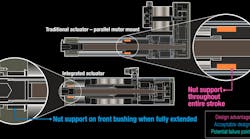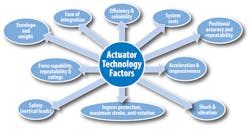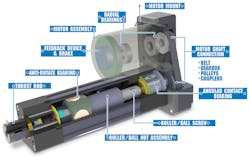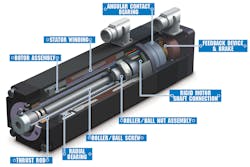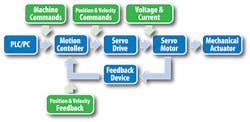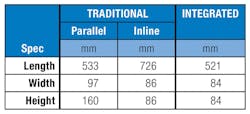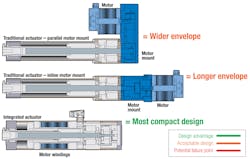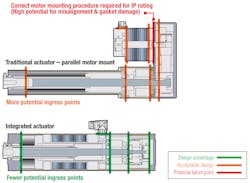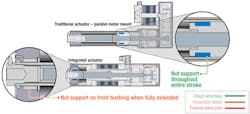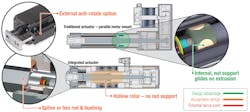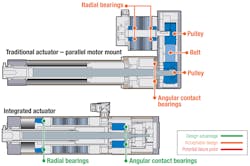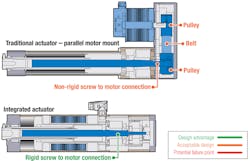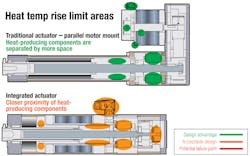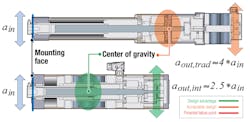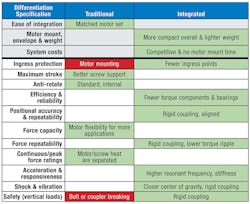In the world of fast-paced industrial automation, design engineers build machines to meet evolving and demanding requirements. Choices for linear motion include a wide selection of electric actuators, both integrated and traditional, that are reliable and efficient. Each technology offers performance advantages depending on the application type and requirements. There are several factors to consider when evaluating integrated and traditional actuators. Knowing how to assess the differences and what to compare will help engineers meet their projects’ specific requirements.
Traditional actuators consist of a screw driven by an external motor attached by a coupler, belt, or gearbox to an actuator. The screw is supported by an angular contact ball bearing set. A nut assembly coupled to the thrust rod provides anti-rotation (typically internal), creating linear motion.
Here’s a cutaway image of a traditional actuator assembly.
Integrated actuators include a screw rigidly coupled to and driven by an internal hollow-core servo motor. The screw and a nut travel within the hollow-core rotor of the internal servo motor. A set of angular contact ball bearings supports the screw and servo motor roto. Anti-rotation is applied (typically externally) to the thrust rod and nut, creating linear motion.
This is a cutaway of an integrated actuator assembly.
Ease of Integration
As speed-to-market pressures increase, an important factor to consider when building and commissioning new machines is how easily each component interacts with the entire machine.
Traditional actuators (mechanical actuator and external servo motor with feedback device) are typically sourced with the servo drive and motion controller included. An integrated actuator combines the mechanical actuator and servo motor into one motion module that is combined with the servo drive and motion controller.
A third-party servo motor mounted to a traditional actuator. This motor is usually made by the servo drive’s manufacturer, thus facilitating integration between motor, drive, and controller with compatible connectors, feedback, devices, and cables. Actuator suppliers can also provide or recommend the correct motor-mounting hardware, such as belts, pulleys, fasteners, and motor-mounting plates. Motor mounting, usually done at the customer site, requires accurate shaft engagement, motor alignment, and belt tensioning to avoid issues such as side loading the motor shaft. Mounting the motor-adds time to the overall integration and commissioning processes.
Integrated actuators use connectors and feedback devices engineered to match those of leading servo motor manufacturers on the market. Machine designers can use standard servo drive and motor cable offerings from the drive manufacturer to facilitate electrical and mechanical integration with the servo drive. Integrated actuators save designers commissioning time by eliminating motor-mounting and the additional components.
An advantage of integrated actuators is that they maintain mechanical form, fit, and function for several controllers by changing the feedback device and connector options to match each controller brand without requiring changes to the mechanical design of the machine. Traditional actuators would require two different servo motor brands, which could drive requirements for several mechanical designs to accommodate the variety of servo motor dimensions from brand to brand.
Envelope and Weight
Traditional actuators, which require an external motor mount, typically offer both motor fold-back (also known as parallel motor mount) and inline motor-mount options. When comparing actuator overall length, both a traditional parallel mount actuator (25 to 75 mm) and traditional inline mount actuator (200 to 250 mm) are longer when compared to an integrated actuator with similar performance. Some of these difference in length between integrated and traditional inline actuators depends on the motor and feedback options selected.
For height comparison, integrated actuators are typically 2 to 3 mm shorter than traditional actuators with inline motor mounts and significantly more compact than a parallel motor-mount configuration. The parallel configuration extends the height of the actuator by as much as 430 to 460 mm. The width of traditional actuators are usually similar to an integrated actuator or slightly larger, depending on the motor used.
This table compares the sizes of Tolomatic’s electric actuators.
Weight comparisons are often essential for applications such as robots and other mobile applications where the actuator is part of the moving mass. The weight of traditional actuators depends on the motor used and additional components such as gearboxes. All three actuator configurations can offer similar weights, again dependent on the motor and mounting components.
In certain applications, an integrated actuator may be an advantage. Its compact design places the center of gravity along the center axis of the actuator and closer to the mounting face. This gives the actuator more efficient movement, a trait useful for robot end-of-arm applications. If weight is a key factor, compare all three actuator configurations with the motor sized for application requirements to ensure the best configuration.
This comparison shows integrated actuators are the most compact.
It’s possible that both actuators meet an engineer’s design and performance specifications for a project. If so, then cost is important. The purchase cost of a traditional actuator is often less than that of an integrated actuator, but when traditional actuator costs include the servo motor, the overall cost typically becomes slightly higher. Integrated actuators are competitively priced and eliminate motor-mount time, often making them the economical option.
Platform Considerations
Traditional actuators with externally mounted motors require more components, resulting in more joints that must be sealed to keep water from entering the actuator. Comparing two similar-performance actuators reveals that a traditional actuator had 10 seals/gaskets and 34 external bolts. The similar integrated actuator had six seals/gaskets and 16 external bolts. With fewer joints and fasteners, integrated actuators have fewer ingress points compared to traditional actuators, making them the choice for demanding applications subject to high-pressure wash-downs or for outdoor applications where environmental conditions (rain, snow, etc.) result in water around the actuator.
With reduced mechanical joints and fasteners, integrated actuators have fewer potential ingress points.
Traditional actuators provide better nut support which allows for longer strokes.
Both traditional and integrated actuators use fixed/free screw supports. One important difference between the two actuators is the roller/ball nut is supported at the point it attaches to the thrust rod in traditional actuators. The support moves with the actuator through the entire stroke. With the nut’s support, typical traditional actuators can have 1.5-m strokes. An integrated actuator, however, uses a hollow-core rotor, which cannot provide nut support throughout the stroke. This results in strokes limited to 600 mm for some models because the fixed-location nut, known as thrust rod front bushing, does not travel throughout the stroke.
Traditional actuators provide standard internal anti-rotation mechanisms while maintaining IP ratings.
Anti-rotation
The nut support for traditional actuators serves a second purpose by providing anti-rotation, which is necessary for linear motion. The nut contacts and slides along the actuator housing extrusion, allowing for anti-rotation throughout the stroke. Integrated actuators typically use the design prevent rotation. If anti-rotation is required, external guide rods or special thrust rods such as a hex shape or spline are options. Both splined and hex rods provide internal anti-rotation, but sealing challenges make them difficult to use in applications requiring IP65 ingress protection ratings.
Efficiency and Reliability
Efficiency and reliability differences between integrated and traditional actuators are driven by the number of torque transmission and rotating components in each. Misalignment and the resulting side loading also lower efficiencies. In integrated designs, only two support bearings (radial and angular contact bearing) are required, and alignment is tightly controlled within the assembly.
Traditional actuators have higher component counts and require three to four bearings: two radial bearings in the motor and a set of screw support (angular contact) bearings. Additionally, traditional actuators use belt-and-pulley assemblies in parallel motor-mount designs or a coupler in the inline configuration. These additional torque transmitting components are subject to wear, misalignment, and potential side loading, which can further lower efficiency through increased friction and also lower overall potential system reliability.
Integrated actuator designs have fewer components, which eliminates additional bearings and motor connection components that can wear and fail, making integrated designs more reliable. Integrating the motor assembly of traditional actuators requires accurate alignment and belt tensioning. Over-tensioning the belt creates a side load to the motor shaft, decreasing efficiency and increasing the chance of premature motor bearing failure. Additionally, if a gearbox is used, its efficiency will reduce overall system efficiency. In summary, integrated actuators reduce friction and operate at a higher efficiency levels due to reduced component counts.
With fewer components, integrated actuators are more reliable and more efficient.
Postional Accuracy and Repeatability
Although the same screw design (ball or roller) can be used in integrated and traditional actuators, the connection between servo motor and screw minimizes backlash at this location, which directly affects positional accuracy and bi-directional repeatability. Integrated actuators use a rigid connection between the rotor and screw shaft, resulting in a coupling style that does not introduce backlash into the system. Traditional actuators rely on a belt-and-pulley mechanism, motor coupler, or a gearbox to attach the motor’s shaft (rotor) to the screw. These connection options typically result in ~0.1 to ~0.5 deg. of backlash, which degrade the actuator’s positional accuracy and bi-directional repeatability.
Integrated actuators’ rigid motor connections provide better positional accuracy and bi-directional repeatability.
Force, Repeatability, and Ratings
Traditional actuators can handle large-diameter ball and roller screws. Integrated actuators limit the size of the screw, as it must travel inside the servo-motor’s hollow-core rotor. This lets traditional actuators achieve peak force ratings upwards of 445kN (or 100k lbf). Integrated actuators can generate around 54kN (or 12k lbf).
The flexibility of a traditional actuator platform to accept a wide variety of motors (different windings for speed and torque), as well as gearboxes (variety of gearing ratios) lets traditional actuators be tuned for specific applications and expands their application coverage. Engineers can source and match servo motor/gearbox combinations to get the speeds and forces required for an application, further increasing the flexibility of traditional actuators.
Servo motors affect the repeatability of the actuator’s force from stroke to stroke. Motors with skewed windings have less torque ripple and cogging, which improves the consistency of the force delivered independent of rotor position and thrust rod position. (Segmented windings are machine wound and have the winding segment aligned directly over each magnet pole, whereas skewed windings are hand wound and the winding is skewed or angled through the bore of the motor.) Motors with skewed windings can be specially sourced for traditional actuators. Some integrated actuators also provide skewed motor windings as a standard offering.
An important distinction to consider between manufacturers is whether the actuator’s continuous ratings accounts for thermal limits of critical components. These critical components are typically the servo motor insulation, feedback device, connectors, bearings, the screw, and the grease lubricating it. Keeping the actuator at or below its continuous rating helps ensure it will have the longest operational life. Power losses from the servo motor and brakes, along with frictional losses from the screw and bearings, are the main heat sources.
Traditional actuators can run at higher duty cycles and deliver higher peak forces for extended times because heat created by the servo motor and brakes are separated. The motor is not in the same housing as the screw, so it does not feel the heat created by the screw and bearings. This separation reduces temperature in the motor and screw. The additional surface area from mounting the motor separately increases heat transfer to the air. This makes traditional actuators a better choice for applications in high-temperature environments.
An integrated actuator, with its compact design, puts the servo-motor windings near the screw, which puts heat from the windings and bearings in close proximity. This increase the temperature of critical components when running at a high duty cycle or delivering high peak forces.
An advantage of integrated actuators is that the ratings of all components in the system are considered and engineered to match one another. A traditional actuator allows for a variety of motors and gearboxes to be mounted to the actuator. These various combinations often generate speeds and torques that exceed the limits of the mechanical actuator.
Mechanical actuator limits affect controllers and should be factored into the control settings, servo motor, and drive.
Traditional actuators provide better performance in high duty cycle and peak force applications due to more favorable heat dissipation characteristics.
Acceleration and Responsiveness
An actuator’s acceleration capability and responsiveness depend on the servo motor’s electrical and mechanical time constants, as well as the stiffness of the components coupling the servo motor rotor to the screw. The lower the servo motor’s mechanical and electrical time constants (MTC and ETC) are, the faster the rotor will respond to voltage and current inputs to the windings. There are low ETC and MTC servo motors for traditional and integrated motors.
This equation illustrates how both parameters can be calculated from standard motor performance specifications. In this equation, R is the motor winding resistance, Jm is the motor moment of inertia, Kt is the motor torque constant, Ke is the motor back EMF constant, and L is the Inductance of the motor windings.
Additionally, the inertia and stiffness of the components coupling the servo motor rotor to the screw determines the actuator’s resonant frequency response.
The equivalent motor load model (reflected and motor) lets you derive the total torsional stiffness equation and the system resonant frequency equation. Jcis the coupling moment of inertia, Jgb is the gearbox moment of inertia, Jris the load moment of inertia, Jrl is the motor shaft reflected load inertia, St is the torsional stiffness, and fR is the resonant frequency.
Traditional actuators use couplers, belts, pulleys, and gearboxes, all of which influence inertia and compliance (stiffness reduction) between the servo motor and screw. This, in turn, affects the actuator’s frequency response. Integrated actuators use a rigid connection between the rotor and screw to create a stiff torque transmission. This allows for a higher frequency response and lets integrated actuators have higher acceleration rates and increased responsiveness.
The rigid connections in integrated actuator screate a stiff torque transmission which increases acceleration rates and responsiveness.
Shocks & Vibrations and Safety
The distance between the actuator’s mounting face and center of gravity affect its sensitivity to shock and vibrations. Both actuators use a front-face mounting. Shocks and vibrations on the mounting transfer through the actuator. The further the actuator’s center of gravity is from the mounting surface, the larger the stress on mounting fasteners and greater are the accelerations at the end of the actuator. Integrated actuators have centers of gravity much closer to the mounting surface. A given shock or vibration at the mounting surface will be transmitted and magnified through the actuator, increasing by a factor of approximately 2.5 at the farthest point from the mounting surface.
In traditional actuators, which are longer, the same vibration input is magnified by a factor of about 4. As shocks and vibrations are magnified, they often result in higher accelerations at the end of the actuator which can affect both the actuator and connectors and cable.
Integrated actuator are smaller and shorter and have centers of gravity that remain close to their mounting surface during operation. So, they are the preferred choice for applications where shocks and vibrations are common.
Integrated actuators provide a center of gravity closer to the mounting face, resulting in higher tolerance to shock and vibration loads.
Actuator technology plays a significant role in safety for vertical applications where control of the actuator position and load (tooling) in case of a power loss or component failure is critical for operator and product safety. Both traditional and integrated actuator use brakes to hold the motor rotor if there is a power loss. Traditional actuators rely on an external motor with a belt or coupler between the brake and screw. If there is a catastrophic failure of a belt or coupler, the actuator rod and tooling mass would be out of control. In this case, the brake would not be able to stop or control the actuator load from falling due to the failed coupling.
Integrated actuators are ideal for vertical applications with safety concerns. Their rigid connections eliminate potential failure points between brakes and the screw. So, if there is a power loss, the brakes will engage the screw and stop it from rotating.
Due to the wide range of applications, industries, and requirements, it is important that machine designers evaluate both integrated and traditional actuators (advantages and tradeoffs) against their requirements.
Ryan Bourgoine is an engineering supervisor, Aaron Dietrich a marketing director, and Daniel Schmit a product manager at Tolomatic Inc. If you have any questions about electrical actuators call (763) 478-8000 or visit: www.tolomatic.com.
